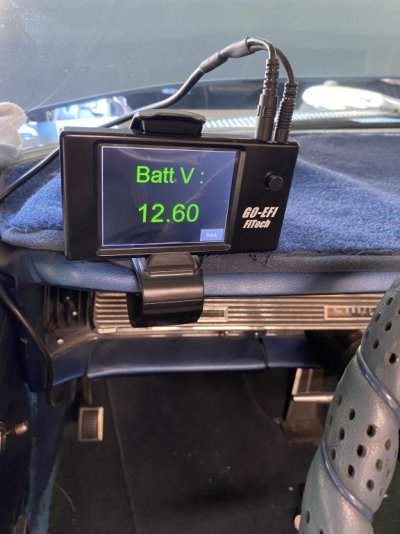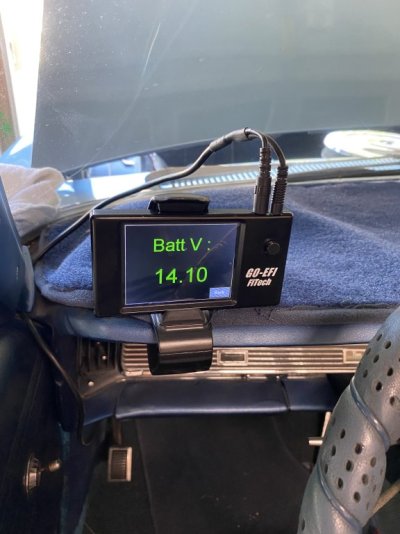@413 had some things to try in post 12. Any luck there? Are your grounds good (VR mount, alternator mount)? One of the symptoms of low/unsteady charging can be bad ground. I am thinking your alternator is ok (more than likely).
You are using an out of date browser. It may not display this or other websites correctly.
You should upgrade or use an alternative browser.
You should upgrade or use an alternative browser.
System voltage is low - Battery not charging
- Thread starter SPF Required
- Start date
Yes…. That last test was with the jumper connected. This last alternator was new, not remanufactured, I was hoping that was going to be the silver bullet this time.
When I returned that Napa one the other day, they hooked it up to a testing machine before they accepted the return. They said that alternator was good too. I may pull this new one out and see if they’ll test it too.
It all feels like I am so close to fixing this issue. I appreciate everyone’s help so far.
When I returned that Napa one the other day, they hooked it up to a testing machine before they accepted the return. They said that alternator was good too. I may pull this new one out and see if they’ll test it too.
It all feels like I am so close to fixing this issue. I appreciate everyone’s help so far.
Alternator post is same as battery, which is roughly the same at the ignition side of the regulator, and continuity of all the waiters leading too/from the alternator check out ok.Get out your voltmeter:
Large black wire at alternator needs battery voltage at all times.
blue wire at regulator needs battery voltage with key on.
Check continuity of green wire from regulator to alternator.
I sanded the firewall where the regulator connects. I suppose I can double check it with a test light at the frame of the regulator? I agree that I think (hope) the alternator is fine.@413 had some things to try in post 12. Any luck there? Are your grounds good (VR mount, alternator mount)? One of the symptoms of low/unsteady charging can be bad ground. I am thinking your alternator is ok (more than likely).
So I have been trying to replace what was there already assuming what was there was working fine. I am not beginning to realize what was there previously may have been undersized all along for the modifications I have in the car.
My 440 is equipped with a Fitech EFI and MSD electro tic ignition (sorry I didn’t mention this earlier). Doing some studying, these two components alone could be drawing up to 40 amps. Add to that the stock electrical components in my 300 might be maxing out the alternator which in turn might be causing the low volts when the car is running. The plot thickens!
My 440 is equipped with a Fitech EFI and MSD electro tic ignition (sorry I didn’t mention this earlier). Doing some studying, these two components alone could be drawing up to 40 amps. Add to that the stock electrical components in my 300 might be maxing out the alternator which in turn might be causing the low volts when the car is running. The plot thickens!
There are no dumb questions in life. Only dumb answers 
I went for a long drive, in the heat, and realized I had a big cooling issue because of lack of flow in the radiator. I got that all figured out, reinstalled, and went to fire it up. Battery wasn’t dead dead, but needed to use my jumper box to get it running. Cruises around a bit to warm it up, and that’s when I noticed the low volts on my Efi control box. Then I went down the rabbit hole of this thread.
But!!! I believe the mystery has been solved. When exploring what it is going to take to run a parallel line suggested by @Big_John i noticed I actually ran a 12 gauge line, not a 10 gauge as indicated in my sketch. I just ran a parallel 10 gauge to that 12 direct to the battery post (with a fusible link) and viola. 14.2 when the engine is running.
Battery volts:

Engine running volts:

I went for a long drive, in the heat, and realized I had a big cooling issue because of lack of flow in the radiator. I got that all figured out, reinstalled, and went to fire it up. Battery wasn’t dead dead, but needed to use my jumper box to get it running. Cruises around a bit to warm it up, and that’s when I noticed the low volts on my Efi control box. Then I went down the rabbit hole of this thread.
But!!! I believe the mystery has been solved. When exploring what it is going to take to run a parallel line suggested by @Big_John i noticed I actually ran a 12 gauge line, not a 10 gauge as indicated in my sketch. I just ran a parallel 10 gauge to that 12 direct to the battery post (with a fusible link) and viola. 14.2 when the engine is running.
Battery volts:

Engine running volts:

I will now work on obtaining replacing the 12 gauge with a second 10 gauge, and doing some concealing of the wires, but this seems to be the fix I needed. I am beginning to think my volts may have been underpowered for some time.
Thank you ALL for your help!

Thank you ALL for your help!
You know... I was just thinking about this while eating my lunch and my latest thoughts were that it must be a bad wire somewhere. You beat me to it!!But!!! I believe the mystery has been solved. When exploring what it is going to take to run a parallel line suggested by @Big_John i noticed I actually ran a 12 gauge line, not a 10 gauge as indicated in my sketch. I just ran a parallel 10 gauge to that 12 direct to the battery post (with a fusible link) and viola. 14.2 when the engine is running.
Thinking out loud, I wonder if you fried a fusible link in the wiring, or just a bad wire or connection.
To help further my education in this….
If I did fry a fusible link, would I still have continuity on that wire? I guess I always thought when a fusible link went, it would break the connect somewhere along the wire. I am not saying the link didn’t break, I just had continuity on the wires when I tested them.
Ordered some 8 gauge wire and 10 gauge fusible links. I will replace what’s in there now at some point with properly gauged stuff. Also have 2 spare solid state voltage regulators coming my way from @FURYGT (he got a new shipment yesterday).
If I did fry a fusible link, would I still have continuity on that wire? I guess I always thought when a fusible link went, it would break the connect somewhere along the wire. I am not saying the link didn’t break, I just had continuity on the wires when I tested them.
Ordered some 8 gauge wire and 10 gauge fusible links. I will replace what’s in there now at some point with properly gauged stuff. Also have 2 spare solid state voltage regulators coming my way from @FURYGT (he got a new shipment yesterday).
Last edited:
Yes, you can still have continuity.If I did fry a fusible link, would I still have continuity on that wire? I guess I always thought when a fusible link went, it would break the connect somewhere along the wire. I am not saying the link didn’t break, I just had continuity on the wires when I tested them.
The best analogy I can think of is this... Suppose you had a length of #10 wire for continuity. Let's say it has 30 strands of wire within the insulator. Seems logical that you would would have continuity between the ends and you do.. It carries all the current you need it to.
Now take that length of wire and strip the insulation back. Let's cut 29 of the 30 strands so you just have one little strand of wire. Obviously it won't allow a lot of current to flow through. Check the continuity and it shows that there is continuity! All it needs is that one strand of wire to show it... Same for dirty connections. The connection might not be good enough to flow any current, but it will show continuity!
In fact, that single strand of wire will check 12 volts.
This may help explain it.
Makes prefect sense! I am going to start calling you Professor @Big_John! I bet I blew that wire on the hot cruise. I had a pusher fan on almost that whole drive. (Well at least I thought it was on!)
SGT FURY
Senior Member
You have the wrong member?
I don’t have any voltage regulators FS?
Not sure what your talking about?
I don’t have any voltage regulators FS?
To help further my education in this….
If I did fry a fusible link, would I still have continuity on that wire? I guess I always thought when a fusible link went, it would break the connect somewhere along the wire. I am not saying the link didn’t break, I just had continuity on the wires when I tested them.
Ordered some 8 gauge wire and 10 gauge fusible links. I will replace what’s in there now at some point with properly gauged stuff. Also have 2 spare solid state voltage regulators coming my way from @SGT FURY (he got a new shipment yesterday).
Not sure what your talking about?
How embarrassing. So sorry. It was meant to be @FURYGTYou have the wrong member?
I don’t have any voltage regulators FS?
Not sure what your talking about?
Corrected in my post above too.
Sorry about that!
Got my wire supplies in today. Does it matter if I put the fusible link on the battery side of the run between the alternator and battery post? I mainly ask because if for some strange reason it goes out again, it is easier to replace the fusible link on that side of the run.
Also, is there an ideal length of fusible link wire I should use? (12 gauge fusible link on 10 gauge wire - I am going to run two parallel wires.
Finally, I am running these wire direct to the battery post. Should they go to the starter relay instead?
Thanks!
Also, is there an ideal length of fusible link wire I should use? (12 gauge fusible link on 10 gauge wire - I am going to run two parallel wires.
Finally, I am running these wire direct to the battery post. Should they go to the starter relay instead?
Thanks!
I am happy to report my car is back on the road! Took it out for about an hour this morning. Cruising volts hovered around 13.8. Thank you ALL for the help and guidance on this one. I learned a lot!
Similar threads
- Replies
- 5
- Views
- 4K
- Replies
- 35
- Views
- 4K
- Replies
- 28
- Views
- 5K

















